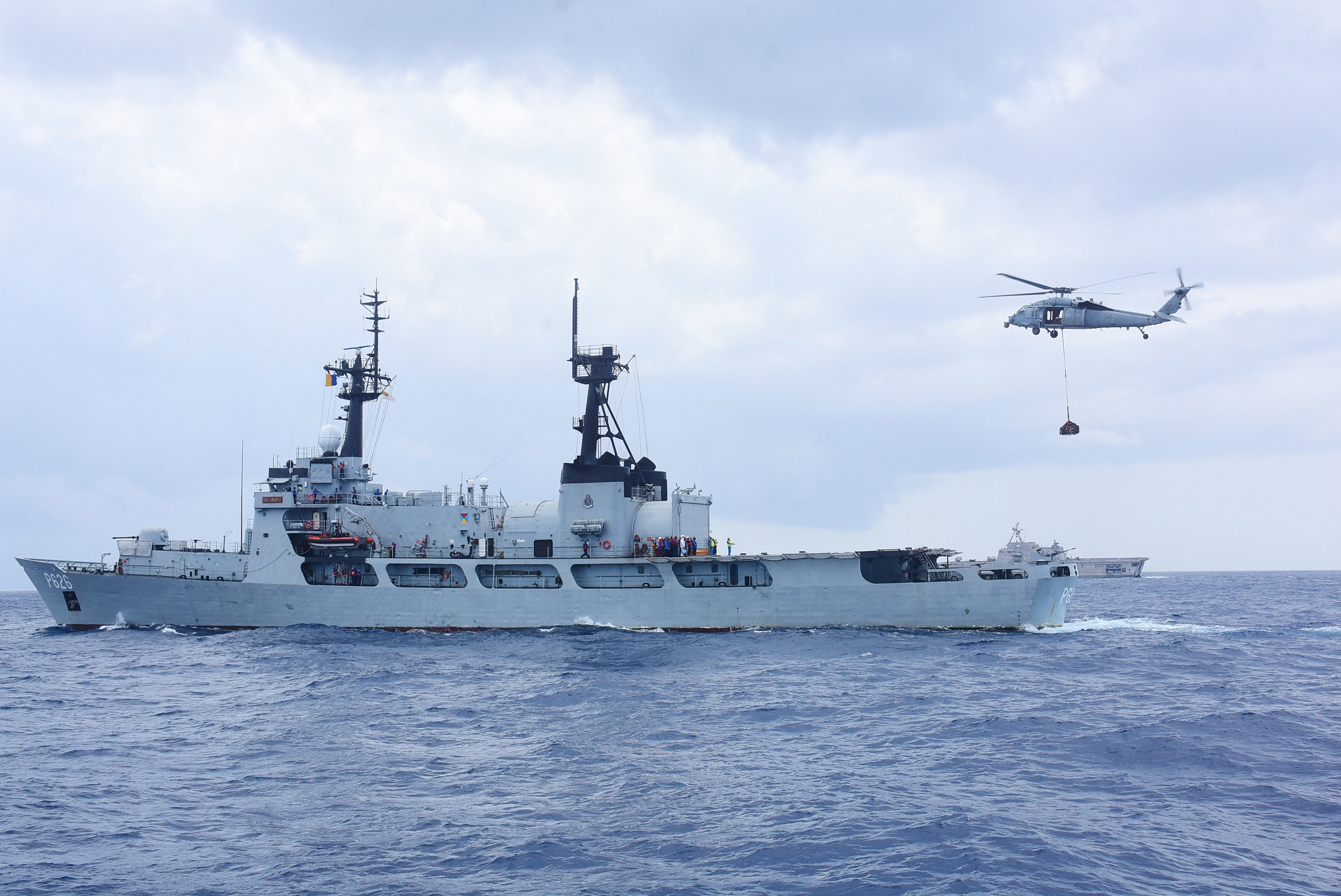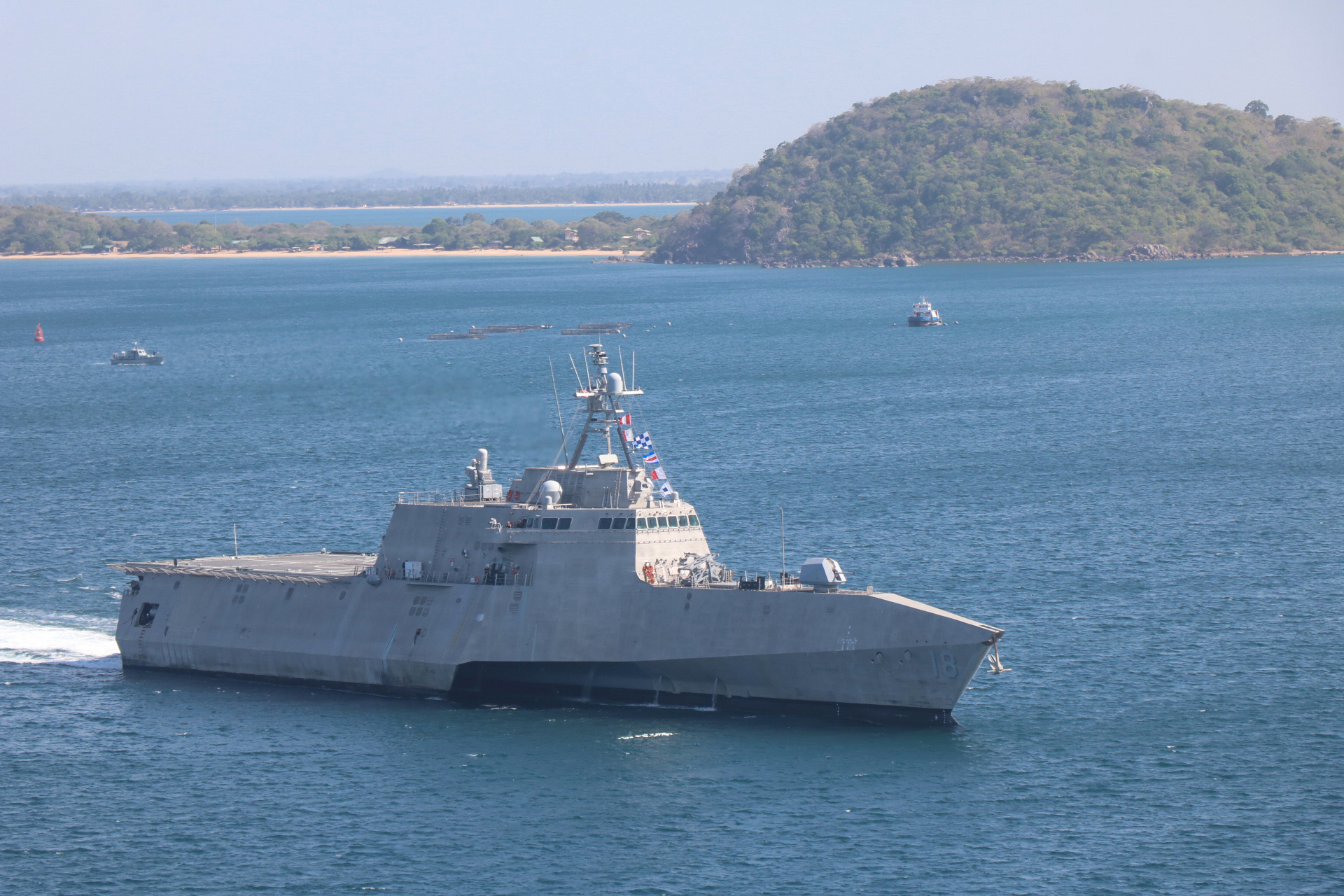U.S., Japan and Sri Lanka Wrap Up CARAT Sri Lanka Exercise
Posted on July 1st, 2021
By: Dzirhan Mahadzir courtesy USNI News

An MH-60S Sea Hawk helicopter attached to Helicopter Sea Combat Squadron (HSC) 21, assigned to Independence-variant littoral combat ship USS Charleston (LCS-18), flies with cargo during a vertical replenishment exercise with Sri Lanka Navy Advanced Offshore Patrol Vessel SLNS Gajabahu (P-626), left, as a part of Cooperation Afloat Readiness and Training (CARAT) Sri Lanka, June 27. Sri Lanka Navy Photo
KUALA LUMPUR – The U.S., Japan and Sri Lanka wrapped up the Sri Lanka Cooperation Afloat Readiness and Training (CARAT) exercise on Thursday.
The U.S. Navy, the Japanese Maritime Self-Defense Force (JMSDF), and the Navy, Sri Lankan Navy and Air Force participated in the drills, which took place over the course of a week and included two days of subject matter expert exchanges (SMEE) and a five-day sea period.
The at-sea phase took place in territorial and international water near Trincomalee, Sri Lanka, where USS Charleston (LCS-18) and a P-8A Poseidon aircraft, assigned to Commander, Task Force (CTF) 72, partnered with ships and aircraft from Sri Lanka and Japan for training,” U.S. 7th Fleet said in a news release. The exercise focused on building interoperability and strengthening relationships through a variety of maritime events and subject matter expert exchanges. Charleston operated with Sri Lanka Navy’s Advanced Offshore Patrol Vessels SLNS Gajabahu (P-626) and SLNS Sayurala (P-623), and JMSDF Asagiri-class destroyer JS Yuugiri (DD-153).”
Activities carried out included divisional tactics meant to hone communication for the ships operating with each other, and a tracking exercise to improve the U.S and Sri Lankan ships’ tracking and targeting capabilities. The vessel used as the ship of interest in the exercise was a dhow of Iranian origin that had been seized by the SLN and is now used for training.
Lt. Lauren Chatmas, a spokesperson for DESRON 7, told USNI News that the SLN has a small fleet of seized Iranian dhows that it employs for training for Sri Lanka and regional partners and that the United Nations Office of Drugs and Crime (UNODC), which specializes in training visit, board, search and seizure (VBSS) teams and in integrating legal and other humanitarian elements, conducted COVID-mitigated training within Trincomalee Harbor using one of these training dhows during the CARAT exercise.
Each event created an opportunity to sharpen our skills, learn from one another, and give us a better understanding of the maritime environment,” Capt. Tom Ogden, the commander of Destroyer Squadron (DESRON) 7, said in a U.S. 7th Fleet news. Sri Lanka, Japan and the U.S. seamlessly worked together with professionalism and adaptability to solve challenging problems during the scenario-based training at sea.”

USS Charleston (LCS 18) arrives in Trincomalee, Sri Lanka, for a contactless port visit ahead of Cooperation Afloat and Readiness at Sea Training (CARAT) Sri Lanka, June 23. (Sri Lanka Navy Media courtesy photo)
Embarked on Charleston is a Navy Seabee detachment assigned to CTF 75 with the personnel integrated with the crew for the underway, giving the opportunity for familiarization of the platform, and to explore integration methods for future operability.
Their role in this exercise was primarily to observe what goes on, particularly on LCS, and to become more familiar with the platform such as what the LCS does, what capabilities we bring to the table so hopefully in the future we can explore future integration for future operability and other possibilities for them to leverage the LCS platform in support of their mission sets,” Cmdr. Joseph Burgon, commanding officer of Charleston’s Gold Crew, told USNI News.
While Covid-19 mitigation measures resulted in limited personal interactions during the exercise, Burgon said the measures did not diminish the quality of the drills.
It was certainly a challenge,” he said, adding that a lot of CARATs are based upon the interaction and exchanges among the different participants involved, in this case most of that having to take place virtually but I think the key here to overcoming those limitations were the early planning and coordination throughout all levels of the chain of command and really making sure that once we got into port, everything was already set up to allow us to have the high-quality exchanges on different virtual platforms to be able to accomplish the objectives we set out to”.
Summing up the at-sea period, Burgon said the three countries involved had a great exchange in communicating and proved that they could operate successfully and proficiently together while conducting complex maneuvers.
I think it really shows how well the communications were and how well the early planning and continued dialogue paid off,” he said.